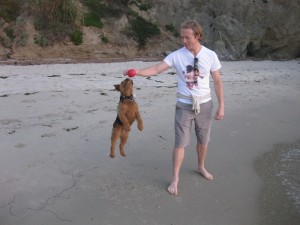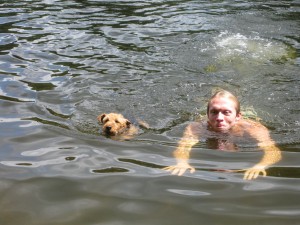Happy Near Year! Have you and your pet been sticking to your New Year's resolutions? Read New Years Resolutions for Your Pet Part 1- Focus on Diet, then take my next recommendation to optimize the quality of life of your canine or feline companion in 2011.
 Part 2- Commit to Daily Exercise
A common scenario I see in my veterinary practice is the phenomena of people choosing pets resembling themselves physically. This observation, for better of worse, typically manifests in many pets’ Body Condition Score (BCS, as discussed on Part 1- Focus on Diet) and level of physical activity correlating to that of their owner.
The PPET (People Pets Exercising Together) Study, which was a partnership between Northwestern Memorial Hospital and Hill's Pet Nutrition, showed that people who regularly exercised with their dog were better able to stick with their workout plan than dog-less participants. A celebrated example of the PPET Study's findings is My Big Fat Greek Wedding actress, Nia Vardalos, who’s dog provided motivation to help her get fit. (see Nia Vardalos’ Dog Manny Promotes Her Weight Loss).
Set attainable and sustainable activity goals for yourself and your pet. Commit to doing physical activity on a daily basis. If you have plateaued or gotten stagnant with your current fitness plan, break through by doing something fresh. Take your dog for a longer walk around your neighborhood. Choose a more challenging hiking trail. Don’t be afraid to get your feet (or paws) wet and go for a swim.
Part 2- Commit to Daily Exercise
A common scenario I see in my veterinary practice is the phenomena of people choosing pets resembling themselves physically. This observation, for better of worse, typically manifests in many pets’ Body Condition Score (BCS, as discussed on Part 1- Focus on Diet) and level of physical activity correlating to that of their owner.
The PPET (People Pets Exercising Together) Study, which was a partnership between Northwestern Memorial Hospital and Hill's Pet Nutrition, showed that people who regularly exercised with their dog were better able to stick with their workout plan than dog-less participants. A celebrated example of the PPET Study's findings is My Big Fat Greek Wedding actress, Nia Vardalos, who’s dog provided motivation to help her get fit. (see Nia Vardalos’ Dog Manny Promotes Her Weight Loss).
Set attainable and sustainable activity goals for yourself and your pet. Commit to doing physical activity on a daily basis. If you have plateaued or gotten stagnant with your current fitness plan, break through by doing something fresh. Take your dog for a longer walk around your neighborhood. Choose a more challenging hiking trail. Don’t be afraid to get your feet (or paws) wet and go for a swim.
 My dog, Cardiff, and I exercise every day, including New Year’s day morning, when we hiked into the hills of Palms Springs (that’s Bob Hope’s house in the background) to elevate our heart rate and mental state.
My dog, Cardiff, and I exercise every day, including New Year’s day morning, when we hiked into the hills of Palms Springs (that’s Bob Hope’s house in the background) to elevate our heart rate and mental state.
 Pet exercise routines are not exclusive to dogs. If you have a corpulent kitty, create an indoor activity program by using a laser pointer or feather toy intrigue your cat into burning more calories. Elevate the food bowl to a height that requires jumping or climbing to achieve a meal. Divide your cat’s regular feeding into many individual kibble portions, then hide the pieces around the house or toss them to a distance that motivates movement.
Before you start on an exercise program with your cat or dog, arrange for a veterinary exam to ensure your pet is healthy enough for physical activity.
Part Three- Schedule Regular Veterinary Examinations to be posted by Friday, January 7, 2011.
To receive my articles via email, please press the “Don’t Miss a Blog Post” button on the right upper corner of this page or follow this link.
Copyright of this article (2011) is owned by Dr. Patrick Mahaney, Veterinarian and Certified Veterinary Acupuncturist. Republishing any portion of this article must first be authorized by Dr. Patrick Mahaney. Requests for republishing must be approved by Dr. Patrick Mahaney and received in written format.
Pet exercise routines are not exclusive to dogs. If you have a corpulent kitty, create an indoor activity program by using a laser pointer or feather toy intrigue your cat into burning more calories. Elevate the food bowl to a height that requires jumping or climbing to achieve a meal. Divide your cat’s regular feeding into many individual kibble portions, then hide the pieces around the house or toss them to a distance that motivates movement.
Before you start on an exercise program with your cat or dog, arrange for a veterinary exam to ensure your pet is healthy enough for physical activity.
Part Three- Schedule Regular Veterinary Examinations to be posted by Friday, January 7, 2011.
To receive my articles via email, please press the “Don’t Miss a Blog Post” button on the right upper corner of this page or follow this link.
Copyright of this article (2011) is owned by Dr. Patrick Mahaney, Veterinarian and Certified Veterinary Acupuncturist. Republishing any portion of this article must first be authorized by Dr. Patrick Mahaney. Requests for republishing must be approved by Dr. Patrick Mahaney and received in written format.
 Part 2- Commit to Daily Exercise
A common scenario I see in my veterinary practice is the phenomena of people choosing pets resembling themselves physically. This observation, for better of worse, typically manifests in many pets’ Body Condition Score (BCS, as discussed on Part 1- Focus on Diet) and level of physical activity correlating to that of their owner.
The PPET (People Pets Exercising Together) Study, which was a partnership between Northwestern Memorial Hospital and Hill's Pet Nutrition, showed that people who regularly exercised with their dog were better able to stick with their workout plan than dog-less participants. A celebrated example of the PPET Study's findings is My Big Fat Greek Wedding actress, Nia Vardalos, who’s dog provided motivation to help her get fit. (see Nia Vardalos’ Dog Manny Promotes Her Weight Loss).
Set attainable and sustainable activity goals for yourself and your pet. Commit to doing physical activity on a daily basis. If you have plateaued or gotten stagnant with your current fitness plan, break through by doing something fresh. Take your dog for a longer walk around your neighborhood. Choose a more challenging hiking trail. Don’t be afraid to get your feet (or paws) wet and go for a swim.
Part 2- Commit to Daily Exercise
A common scenario I see in my veterinary practice is the phenomena of people choosing pets resembling themselves physically. This observation, for better of worse, typically manifests in many pets’ Body Condition Score (BCS, as discussed on Part 1- Focus on Diet) and level of physical activity correlating to that of their owner.
The PPET (People Pets Exercising Together) Study, which was a partnership between Northwestern Memorial Hospital and Hill's Pet Nutrition, showed that people who regularly exercised with their dog were better able to stick with their workout plan than dog-less participants. A celebrated example of the PPET Study's findings is My Big Fat Greek Wedding actress, Nia Vardalos, who’s dog provided motivation to help her get fit. (see Nia Vardalos’ Dog Manny Promotes Her Weight Loss).
Set attainable and sustainable activity goals for yourself and your pet. Commit to doing physical activity on a daily basis. If you have plateaued or gotten stagnant with your current fitness plan, break through by doing something fresh. Take your dog for a longer walk around your neighborhood. Choose a more challenging hiking trail. Don’t be afraid to get your feet (or paws) wet and go for a swim.
 My dog, Cardiff, and I exercise every day, including New Year’s day morning, when we hiked into the hills of Palms Springs (that’s Bob Hope’s house in the background) to elevate our heart rate and mental state.
My dog, Cardiff, and I exercise every day, including New Year’s day morning, when we hiked into the hills of Palms Springs (that’s Bob Hope’s house in the background) to elevate our heart rate and mental state.
 Pet exercise routines are not exclusive to dogs. If you have a corpulent kitty, create an indoor activity program by using a laser pointer or feather toy intrigue your cat into burning more calories. Elevate the food bowl to a height that requires jumping or climbing to achieve a meal. Divide your cat’s regular feeding into many individual kibble portions, then hide the pieces around the house or toss them to a distance that motivates movement.
Before you start on an exercise program with your cat or dog, arrange for a veterinary exam to ensure your pet is healthy enough for physical activity.
Part Three- Schedule Regular Veterinary Examinations to be posted by Friday, January 7, 2011.
To receive my articles via email, please press the “Don’t Miss a Blog Post” button on the right upper corner of this page or follow this link.
Copyright of this article (2011) is owned by Dr. Patrick Mahaney, Veterinarian and Certified Veterinary Acupuncturist. Republishing any portion of this article must first be authorized by Dr. Patrick Mahaney. Requests for republishing must be approved by Dr. Patrick Mahaney and received in written format.
Pet exercise routines are not exclusive to dogs. If you have a corpulent kitty, create an indoor activity program by using a laser pointer or feather toy intrigue your cat into burning more calories. Elevate the food bowl to a height that requires jumping or climbing to achieve a meal. Divide your cat’s regular feeding into many individual kibble portions, then hide the pieces around the house or toss them to a distance that motivates movement.
Before you start on an exercise program with your cat or dog, arrange for a veterinary exam to ensure your pet is healthy enough for physical activity.
Part Three- Schedule Regular Veterinary Examinations to be posted by Friday, January 7, 2011.
To receive my articles via email, please press the “Don’t Miss a Blog Post” button on the right upper corner of this page or follow this link.
Copyright of this article (2011) is owned by Dr. Patrick Mahaney, Veterinarian and Certified Veterinary Acupuncturist. Republishing any portion of this article must first be authorized by Dr. Patrick Mahaney. Requests for republishing must be approved by Dr. Patrick Mahaney and received in written format.